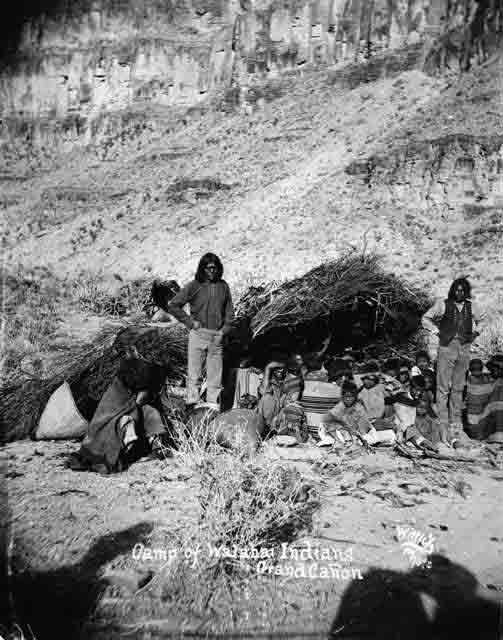
A group of Hualapais, or People of the Tall Pines, living in the Grand Canyon in 1883. The mixing of cultures is evident in the Western clothing of the men, set against the traditional blankets and brush shelter.
Photo by Ben Wittick, courtesy of Western History/Genealogy Department, Denver Public Library.
The Hualapais connect their emergence into this world to the Grand Canyon. Tribal legend tells that the people came into this world from Spirit Mountain (near present-day Bullhead City) and lived on the banks of the Colorado River, eventually migrating to the Colorado Plateau. Their traditional lands extended over about six million acres, from the Colorado River on the west and north, east to the San Francisco Peaks and south to Bill Williams Mountain. Anthropologists believe that the Hualapai and Havasupai were bands of the Pai, who divided up after European contact. The earliest physical remains of the Pai date back to A.D. 600 and were found near Hoover Dam.
The Hualapais traveled in bands as nomadic hunters and gatherers, eating small game, cactus, yucca and piñon nuts. Traveling on foot, they traded with other Native Americans in the Grand Canyon area and as far away as the Pacific Ocean to the west and the Rio Grande to the east. They traded hides to the Havasupai for crops, and traded meat for squash, corn and pumpkins from the Mojave Indians living south on the Colorado River.
Today the Hualapai Nation covers about one million acres, with 108 miles of Colorado River frontage extending from Lake Mead in the west to the boundary of the Havasupai Reservation in the east. The Hualapais’ seal depicts purplish canyonlands in the middle, a testament to the historical importance of Grand Canyon.
The Hualapais have a tourist destination known as Grand Canyon West, visited by about 40,000 people annually. In March 2007, the tribe opened the Grand Canyon Skywalk, a glass-bottomed walkway that juts 70 feet out from the canyon rim. Visitors can look down to see the Colorado River almost 4,000 feet beneath their feet. Visitor information is available at the Hualapai Nation Web site.
Written By Patricia Biggs
References:
- Anderson, Michael F. Living at the Edge: Explorers, Exploiters and Settlers of the Grand Canyon Region. Grand Canyon: Grand Canyon Association, 1998.
- Coder, Christopher M. An Introduction to Grand Canyon Prehistory. Grand Canyon: Grand Canyon Association, 2000.
- Hualapai Nation Web Site.

